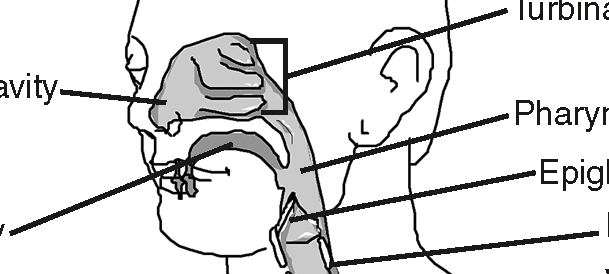Anatomy and Physiology: Lungs, Bronchi, Trachea, Nose
Lungs, Bronchi, Trachea, Nose
I know, I know, breathing always makes you think about lungs, but how does the air in the lungs get there? Despite the primary function of gas exchange, a significant portion of the respiratory system is only for transport, but the body takes advantage of this extra, non-respiratory space, and puts it to good use. You can see the respiratory organs in Figure 13.1.

Figure 13.1The organs of the upper and lower respiratory system. (LifeART©1989-2001, Lippincott Williams & Wilkins)
Conducting Portion
A typical breath (or tidal volume) is about 500 ml, but of that portion only about 350 ml actually are involved in gas exchange (O2 in, and CO2 out); that region is called the respiratory portion. That leaves a volume of 150 ml that the air must pass through in order to get to the respiratory portion; that smaller volume is also called the conducting portion. This region consists of the nasal cavity, mouth, pharynx, trachea, bronchi, and bronchioles. This anatomical dead space limits the size of snorkel tubes; a snorkel tube merely extends the anatomical dead space, and if the tube were too long, the tidal volume would keep circulating air within this larger dead space, and you would not get the oxygen you need (this also explains why old diving suits needed pumps to continually force air down to the divers below).
Imagine seeing the sun shining through the window. What do you see in the air? Have you ever noticed the light reflecting off all the dust floating in the air? Well that dust—or rather dead skin cells, plant matter, hair, and dust mite feces—is in every breath you take! Gross! That's not all! Have you ever noticed areas that haven't been dusted in a while? That gray coating on the furniture has the potential of forming inside your lungs!
This is where the glory of the conducting portion comes in. Just as the conductor of a train has many tasks, far beyond just collecting tickets, the conducting portion is also a master at multitasking. For one thing, the conducting portion of the respiratory system, particularly the nose, is the major gateway for infection, so the body has to be prepared with defenses. Despite the conducting portion being very big on the division of labor, there is, nonetheless, quite a bit of overlap. And so, let's go on down.
Nasal Cavity
Once again, a very useful way to learn what a part of the body does is to observe the effect of its absence. Even though most breathing occurs through the nose, the mouth is also useful, especially when you are out of breath. If you have ever slept with such a badly stuffed-up nose that you had to breathe through your mouth all night, you probably woke up with the effects of having no nose: Your throat was probably very sore.
Why? First of all, let's look at the passageway when you breathe through the nose (see Figure 13.2). After the opening vestibule (nostril or nare) the air passes through the passage and down the nasopharynx, which is the portion of the pharynx behind the nose (the oropharynx is the portion, as you would imagine, behind the mouth).
Inside your nose you have a series of structures called turbinates. Whenever you breathe, the air is forced over the turbinates. Every turbinate is covered with a mucous membrane. This mucus serves two functions. One function is to trap a lot of the dust that you see floating in the sunlight from your window. This function continues all the way down to the lungs. This is very helpful, because a lot of bacteria and viruses are carried along with that dust. Given that the mucus will dry over time, much of it gets caught in the nose hair, which are called vibrissae (which incidentally is the same name given to the whiskers of a cat, too).

Figure 13.2The nasal cavity helps to warm, filter, and humidify the air before it reaches the pharynx. (LifeART©1989-2001, Lippincott Williams & Wilkins)
As you can see from Figure 13.3, turbinates are surprisingly curly. This shape is directly related to the second function of the mucous membrane on the turbinates. That shape creates a great deal of turbulence in the air whenever you breathe; the turbulence forces air over the mucous membrane, both warming and humidifying the air. Breathing through your mouth all night prevents the air from moistening, which results in your sore throat the morning after.
The turbinates make another good use of that turbulence whenever you pass a beautiful flower garden, or savor the aroma of an upcoming meal. At the very top of the nasal cavity is the olfactory nerve. Now close your eyes, and imagine smelling your food to determine what special ingredient is a part of the recipe. Did you imagine yourself breathing in more deeply? By breathing in more deeply you create more turbulence in the nasal cavity, which forces the air to the very top of the nasal cavity exactly where the olfactory receptors are found. Funny how so many things make sense when you think about them!

Figure 13.3The turbinates, shown here in a frontal section; this patient has a deviated septum. (LifeART©1989-2001, Lippincott Williams & Wilkins)

Excerpted from The Complete Idiot's Guide to Anatomy and Physiology © 2004 by Michael J. Vieira Lazaroff. All rights reserved including the right of reproduction in whole or in part in any form. Used by arrangement with Alpha Books, a member of Penguin Group (USA) Inc.
To order this book direct from the publisher, visit the Penguin USA website or call 1-800-253-6476. You can also purchase this book at Amazon.com and Barnes & Noble.







